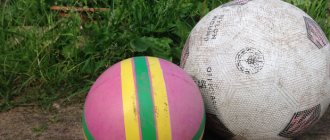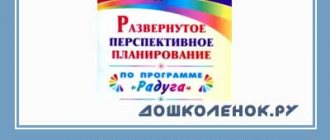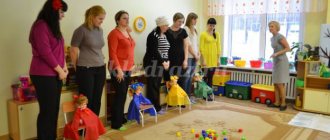Summary of GCD on traffic rules in the early age group
Summary of GCD on traffic rules in the early age group “Magic Lights”
I bring to your attention a summary of direct organized activities on traffic rules in the early age group “Magic Lights”.
This material can be used by teachers in preschool educational institutions. This summary is aimed at strengthening the skills of safe behavior of children on the street, instilling cultural behavior on the road, and studying the Rules of the Road. Goal: 1. Teach children to distinguish colors: red, yellow, green. 2. Introduce children to traffic lights and the rules for safely crossing the road at a pedestrian crossing. Educational task: to instill in children a sense of responsibility, instill cultural behavior on the road. Preliminary work: 1. Looking at illustrations about traffic rules 2. Reading poems and stories about traffic rules 3. Showing a toy traffic light and looking at it, talking about the purpose of the traffic light. 4. Familiarization with the road markings of a pedestrian crossing - “zebra” 5. Role-playing games Material: mugs of three colors (red, yellow, green), a basket, a traffic light toy, a pedestrian crossing sign, multi-colored cardboard steering wheels, four identical strips of white paper - pedestrian crossing, toys: dog and hedgehog.
Progress of the lesson:
The dog comes and brings red, yellow and green mugs in a basket.
The teacher offers to take the children one mug each. Children take one mug and name its color. The teacher asks the children who have red mugs in their hands to come out. Red color - no access!
The teacher asks the children who have yellow mugs in their hands to come out. Yellow - be ready for the journey,
The teacher asks the children who have green mugs in their hands to come out. And the green color - go!
(If the children make a mistake, the dog barks loudly, and the children correct the mistake) The teacher offers to play the game “Cars”. Children take the steering wheels in their hands and drive in a circle in one direction, reading a poem. We're driving, we're driving, we press the pedal.
We switch gears, We look intently into the distance. The windshield wipers clear the drops to the right, to the left. Purity! The wind ruffles my hair. We are drivers anywhere! The color lights up red (the teacher shows a red circle) - the children - the cars stop, the light turns green (the teacher shows a green circle) - the children - the cars drive on, reading the poem.
There is a knock on the door.
A hedgehog comes in, says hello, and tells the children how he was in a hurry to get home to his hedgehogs, but couldn’t cross the road because there were a lot of cars on the road. The hedgehog asks the teacher and the children to teach him how to cross the road correctly. Educator: Guys, let's show the hedgehog how pedestrians behave on the road? Children (in chorus): Yes. The teacher reads a riddle about a pedestrian crossing: The stripes are familiar to everyone. Children know, adults know. Leads to the other side (points to the crossing) Children: pedestrian crossing! (in unison) Let's show the hedgehog how to cross the road at the pedestrian crossing! Game "We are pedestrians." There are children standing at the pedestrian crossing and a hedgehog in the hands of one of the children. Waiting for the traffic light to cross the street. The teacher shows a red traffic light: “Can I cross the road?” Children: No. The teacher shows the green traffic light: “Can I cross the road?” Children: Yes. A hedgehog and children cross the road at a zebra crossing. The game is repeated several times.
After the game, the hedgehog turns to the children: “Thank you, guys! Now I know how to cross the road correctly. And you remember that you can only cross the road with adults at a pedestrian crossing and only when the traffic light is green! Goodbye, guys!" The guys say goodbye to the hedgehog and the dog. The lesson is over.
We recommend watching:
Summary of GCD in the first junior group on traffic rules From the experience of working as a kindergarten teacher. Game for children of primary preschool age Didactic game on traffic rules in an early age group Synopsis of an integrated lesson for an early age group “Sorceress - water”
Similar articles:
Games to develop classification skills for children 2-3 years old
Games for the development of the articulatory apparatus for children 2-3 years old
Games for teaching counting with children 3-4 years old
Didactic tasks for a walk in kindergarten. Junior preschool age
Training children of the younger group in labor activities
Open lesson on traffic rules in the first junior group “Our friend the traffic light”
Summary of an open lesson on traffic rules in the first junior group “Our friend the traffic light.”
Program content: Continue to develop safe behavior skills.
Objectives: 1. To consolidate children’s ideas about traffic lights, its signals, and actions.
2. Consolidate knowledge of primary colors (red, yellow, green).
3. Develop speech activity through introducing words into the active vocabulary: traffic light, red, yellow, green.
4. Instill in children a friendly attitude towards animals and a desire to help them
5.Reinforce the ability to draw with a brush over a sketch.
Materials: Bunny toy, traffic light model, traffic light sketches, green and red paints, brushes, laptop, cartoon about traffic lights.
Progress of the lesson
-Guys, look how many guests have gathered! -Let's say hello to them. - Hello! - Guys, on the way to kindergarten I met a bunny who was sitting under a bush and crying bitterly. - I asked the bunny what happened? - The bunny told me that he ran away from the forest from his mother, from his family. - And he ran to the city, where there are a lot of cars. - Now he doesn’t know how to get back to the forest. - He approached the road and doesn’t know how to cross it. - I told him: Zainka, don’t be upset! - Come visit us, in the children's room, we will tell you and the guys and show you how to cross the road correctly. (knock on the door). - Guys, here comes the little bunny in a hurry! -Let's say hello to him. -Hello, bunny! -Come in! -Guys, let's now tell the bunny how to cross the road correctly. -Now I'll tell you a riddle, and you listen to it carefully.
Day and night I'm burning
I'm giving signals to everyone.
I have three colors
What's my friends name?
(traffic light)
- That's right, guys! - Well done! - This is a traffic light. - Why do we need a traffic light? Children: To cross the road. - That's right. - We've already looked at the traffic light, let's remember what kind of lights the traffic light has? (red, yellow, green). - If the red light is on, it means the path is closed! -Yellow - wait a little! - And the green light is on - this means the way is open! - Here, guys, you and I remembered what lights the traffic lights have. -Danya, what does the red light tell us? (the path is closed), - Vika, what does the yellow light tell us? (we have to wait), - Styopa, what does the green light tell us? (the path is open). - Well done guys! - That's right! - Now let's warm up a little and play with bunny
Physical school
Traffic lights have three colors
They are clear to the driver
Red light - no way through (squat down)
Yellow - be ready to go (get up, stop)
And the green light is rolling (running in a circle)
- That's how we played well. - Guys, so that the bunny doesn't forget you and I how to cross the road correctly. - Let us now look through our magic window and see how the traffic light works on the road. (Watch a cartoon) .- Guys, you and I looked through our magic window and saw how a traffic light works on the road. - Guys, the bunny tells us that he liked the traffic light and he remembered how to cross the road. - Let's draw a traffic light for him and for his forest residents. - What if they find themselves in the city, so that they also know how to cross the road. - Go to the table, sit on the chairs. - Guys, look at my traffic lights, are all the lights on? (no). - Now look at your traffic lights. -Which lights are not lit at your traffic lights? (red, green), (I ask each child what color they will use to draw the lights). - Guys, what are we going to use to draw the lights? (with a brush). - That's right. - We hold the brush with three fingers (I show how to draw the lights). - Now let's draw the lights with you. - Well done guys! - Look what beautiful traffic lights we have turned out. - Let's give our traffic lights to the bunny and he will take it to the forest dwellers so that they don’t forget how to cross the road correctly. - Guys, the bunny says “thank you” to us! -He thanks us for telling him about the traffic light, and now he knows how to cross the road. -And now Bunny hurries to his friends and says “Goodbye” to us. -Well done guys! -Now we remember why a traffic light is needed and how to cross the road. -Let's tell our guests: Goodbye!
Consultation for parents on traffic rules in the nursery group.
MBDOU "Kindergarten No. 9 "Constellation"
Consultation for parents
according to traffic rules in the nursery group.
Prepared by: Datkhuzheva E.K., Chuts F.Ch.
2019
Rules for parents
The child begins to become familiar with the rules of the road
long before entering kindergarten. He receives his first knowledge and experience from
observations of your loved ones, parents. Therefore it is very important that
the parents themselves not only knew, but also adhered to in everyday life
traffic rules. The kindergarten is actively working on
studying traffic rules with children. But only your parents
personal example, assessment of behavior will be able to translate these rules into norms
child's behavior. The recommendations below are considered
Typical traffic situations that need to be constantly monitored
children's attention.
The main danger is a standing car!
A stationary car is dangerous: it can block another
a car that is moving at high speed interferes with time
notice the danger. You cannot go out onto the road because of parked cars. IN
as a last resort, you need to carefully look out from behind a standing car,
make sure that there is no danger and only then cross the road.
Do not go around a stationary bus, either in front or behind!
A stationary bus covers a section of the road along which
the moment you decide to cross it, a car may be passing. Except
In addition, people near the bus stop are usually in a hurry and forget about safety. From
stop, you must move towards the nearest pedestrian crossing.
Know how to anticipate hidden dangers!
Due to a standing car, house, fence, bushes, etc.
a car suddenly leaves. To cross the road you need to choose this
a place where the road is visible in both directions. As a last resort,
you can carefully look out from behind the obstacle, make sure that there is no danger, and
only then cross the road.
The car is approaching slowly, but you still have to let it pass.
A slow moving car may be hiding a car behind it,
going at high speed. The child often does not suspect that behind one
another one may be hidden by the machine.
And at a traffic light you can meet danger.
Today on city roads we are constantly faced with the fact that
car drivers violate traffic rules: they rush
high speed, ignoring traffic lights and crossing signs. That's why
It is not enough to teach children how to navigate when a traffic light is green,
it is necessary to ensure that there is no danger. Children often reason
like this: “The cars are still standing, the drivers see me and will let me through.” They
are wrong.
Children often run across a “deserted” street without looking.
On a street where cars rarely appear, children run out onto the road
without first examining it, they end up under a car. Work out
It’s a child’s habit to always look around before going out on the road.
stop, listen - and only then cross the street.
MAGAZINE Preschooler.RF
Summary of the traffic rules lesson in the first junior group “Our assistant traffic light”Purpose of the lesson: Continue to develop safe behavior skills in children;
Tasks:
- consolidate knowledge of the basic colors of traffic lights (red, yellow, green), the shape of a circle
- consolidate children's understanding of traffic lights and their actions
- develop attention and speech.
Materials for the lesson: 3 layout of a traffic light, glue, brushes and napkins according to the number of children, a bunny toy, circles of red, yellow, green colors (according to the number of children), an image of a zebra, a layout of a pedestrian crossing.
Individual work: consolidate knowledge of the location of traffic light colors, monitor the correct sequence of traffic light colors (red, yellow, green).
Progress of the lesson:
Surprise moment: A bunny comes to visit the children
Organizing time:
Educator: guys, a bunny came to visit us today, he came to us from his doll town, he is very interested in how our children play in kindergarten. Let's say hello to the bunny in unison.
Children: say hello
Educator: Leads the children to the traffic light and asks
Guys, look here, what is this worth here?
Children: traffic light
Educator: Why do we need it?
Children: A traffic light helps adults and children cross the road correctly
Educator: He stands on the streets of the city and with his eyes shows people and cars when they can drive or cross the road. Guys, let's count together how many eyes he has?
Children: Counting
Educator: Artem, what kind of eye does the traffic light have below?
Dasha, what kind of eye does the traffic light have at the top?
Sofia, what kind of eye does the traffic light have in the middle?
Educator: Now let's remember what we do if the light is red?
Children: standing
Educator: What do we do if the light is yellow?
Children: get ready to go
Educator: What if the green light turns on?
Children: go
Educator: Now let's go for a walk. Look how interesting the path is.
What's on the path?
Children: stripes.
Educator: What color are they?
Children: white, black.
Educator: Look what I have in my hands?
Children: zebra
Educator: This is such a horse. It has white and black stripes. This horse's name is zebra. Repeat, what is the horse's name?
Children: zebra.
Educator: Our track has the same stripes as the horses. That's why she is also called zebra. This is a pedestrian crossing. You can cross the road on it when the green eye at the traffic light is on. Look at the little eye on the traffic light?
Children: green.
Educator: that means you can cross the road. Guys, come in pairs and we will cross the road.
Children: crossing the road.
Teacher: reads a poem
If the light turns red, it means it is dangerous to move.
Yellow warning light, wait for signal to move.
The green light says: go ahead, the path is open.
Educator: guys, the bunny came to visit us and we shouldn’t let him go without a gift. We will make a traffic light for his doll town so that he also knows the rules of the road and is very attentive (children sit at tables on which there are traffic light models)
Practical part:
Each of you has eyes - these are circles made of colored paper.
First we take the red circle, this is the upper eye of the traffic light. And put it on top.
Then we take the yellow eye - this is the middle eye of the traffic light. We put it under red. And the last green circle is the bottom eye of the traffic light. Try to glue evenly and carefully so that the bear likes your traffic lights.
The teacher approaches the children and conducts individual work (monitors the sequence so that they are evenly positioned).
Educator: What does the color red mean?
Children: standing
Educator: What does the color yellow mean?
Children: ready to go
Educator: What does the color green mean?
Children: let's go
Educator: Well done, guys. Everyone did a very good job. I hope you all cross the road correctly. Always be attentive and careful.
The bunny thanks the children for the gifts.
The bunny says goodbye to the children.
Children: say goodbye to the bunny.
| Next > |


